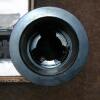I remember when macpherson struts were being advertised as a quality attribute. They were for the assembly line, made assembly of the suspension faster, but the things require spring compressors and a re alignment to change. I liked the old, external shock absorber.
Similarly, what we read in print is advertising, and short action bolt guns (that is 308 length) are just another difference hyped into an advantage.
short action M70


long action pre 64 M70


not a lick of difference of accuracy on target. I have not seen an analysis for conventional actions showing that short actions are stiffer than long. Or that it makes a difference on target, such as a long action M70 or M700 and a short action M70 or M700. Now if the sidewalls are thicker, it makes a difference.




Un necessary length is un necessary. One reason the K31 action was developed.
K1911


K31


It is easy to see the longer bolt required a longer receiver. That added weight and reduced barrel length for the same OAL of the rifle.
I shot out two barrels in this 30-06 Mauser in NRA Highpower competition. It is a long action.

The primary problem I had with the long action was I had to move more, in rapid fire, to get out of the way of the bolt. The long action is about 1/2" longer than a short action. When I finally scoped the bugger, I added a big chunk of wood from a pallet (nail holes included) and got my face away from that scope.

Lost that Cloward handstop for about a year, that scared me. James Cloward was a 1960's Highpower champ and 1000 yard winner, and when he died, Cloward handstops were no longer available.
For a military rifle, a shorter action is desirable. A good example is the M1 Garand, used the 30-06. When the 30-06 was developed, it had an air space. That was not a huge problem in 1903 with a bolt rifle, but when full auto and semi auto mechanisms came into being, that extra half inch added weight to the cartridges and the guns. And length limits cyclic rate, with all that mass moving in thousandths of a second.

So, post WW2, the Army developed a cartridge, the 7.62 NATO, which equaled the 30-06 performance, but was a half inch shorter.







